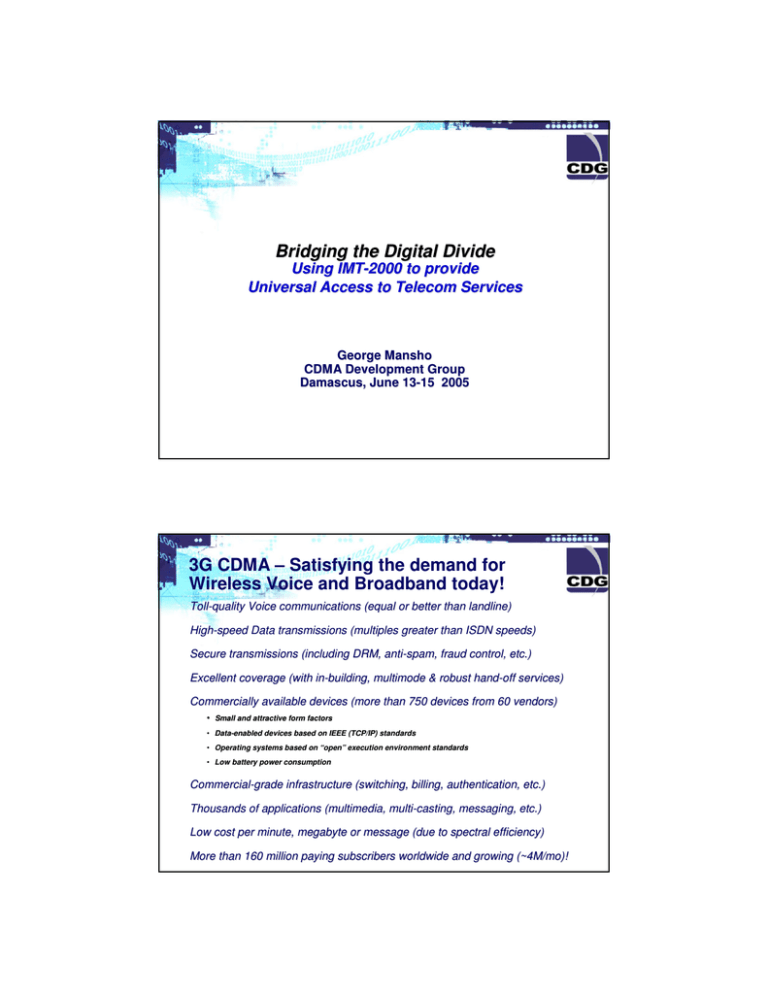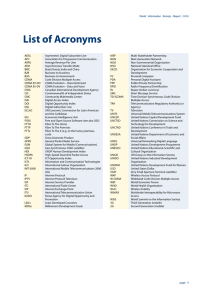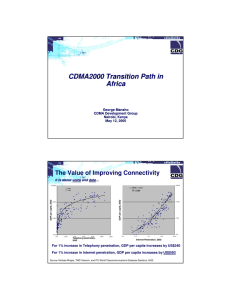Bridging the Digital Divide Using IMT - 2000 to provide
advertisement

Bridging the Digital Divide Using IMTIMT-2000 to provide Universal Access to Telecom Services George Mansho CDMA Development Group Damascus, June 1313-15 2005 3G CDMA – Satisfying the demand for Wireless Voice and Broadband today! TollToll-quality Voice communications (equal or better than landline) HighHigh-speed Data transmissions (multiples greater than ISDN speeds) Secure transmissions (including DRM, antianti-spam, fraud control, etc.) Excellent coverage (with inin-building, multimode & robust handhand-off services) Commercially available devices (more than 750 devices from 60 vendors) vendors) • Small and attractive form factors • DataData-enabled devices based on IEEE (TCP/IP) standards • Operating systems based on “open” execution environment standards standards • Low battery power consumption CommercialCommercial-grade infrastructure (switching, billing, authentication, etc.) Thousands of applications (multimedia, multimulti-casting, messaging, etc.) Low cost per minute, megabyte or message (due to spectral efficiency) efficiency) More than 160 million paying subscribers worldwide and growing (~4M/mo)! (~4M/mo)! Connecting Citizens Around the World 3G is playing an important role in bridging the digital divide Around the world, mobile phone users are overtaking fixed-line subscribers due to the affordable high-quality voice and data services that are made possible by today’s technologies. The number of wirelessonly homes is growing and there are far more mobile phones than PCs in the world. 3G CDMA networks foster various levels of global connectivity – from wireless local loop to high-speed mobile voice and/or data in many different licensed frequency bands. 3G CDMA enables high-quality voice, wireless broadband access and a variety of multimedia applications making telemedicine, public safety, education, business and entertainment a reality everywhere. Theoretical Cell Sizes (Voice) Reverse link dominates coverage: • Limiting link due to several issues Link budget determines available margin required to achieve a high quality link CDMA2000 CDMA2000 WCDMA • Easy to compare technologies Difference in coverage is affected by a variety of factors, including: GSM CDMA2000 • Morphology • Tower height • H/W and rate set assumptions, etc. Lower Frequencies Provide Greater Coverage and Reduce Base Stations Nominal Nominal cell cell radius radius WCDMA WCDMA GSM GSM CDMA2000 CDMA2000 Freq. Freq. (MHz) (MHz) 2100 2100 900 900 800 800 (Rural (Ruralarea) area) Radius Radius (km) (km) 13.3 13.3 26.9 26.9 29.4 29.4 Area Area 2 (km (km2)) 553 553 2269 2269 2712 2712 BTS BTS Count Count 13.6 13.6 3.3 3.3 2.8 2.8 Source: Lucent Technologies. Note: This is a simplistic estimation that real-world terrain and environmental variables will affect. It assumes all parameters are equal: terrain, output power, antenna height, etc. Spectrum Allocations Providing affordable coverage is crucial in wireless telecommunications. The warmer (lower) frequencies are best! WCDMA 2.1 TD-SCDMA 2.1 GSM 900 CDMA 1.7 CDMA 800 GSM 1.8 CDMA 450 1GHz 802.15.1 Bluetooth 2.4 CDMA 1.9 802.11 b, g Wi-Fi 2.4 2GHz 802.15.3a UWB 3.1-10.6 802.16 LMDS 28-29 802.11 a, e Wi-Fi 5.0 29GHz 11GHz 5GHz 802.16a, e 802.16a, e WiMAX WiMAX 5.8 2-11 cdma2000® 450, 800, 1.7, 1.9, 2.1 Licensed Unlicensed Licensed & Unlicensed Licensed Spectrum vs Unlicensed Spectrum The use of unlicensed spectrum creates interference issues CDMA provides a platform for a number of services Services & Market Technology & Standards Next Generation PAMR(*) Mobile Data Wireless telephony Wireless internet CDMA2000-family of technologies • High Spectrum Efficiency •PAMR - Private Access Mobile Radio Public Cellular • Maximum site capacity use • Ubiquitous coverage • Efficient data transmission •Lowest cost per Mbs 3G CDMA for African Development Large voice telephony market will continue to be serviced by 2G GSM Two new additional markets to be serviced by 3G CDMA: • – Low Cost Voice Telephony: – Opportunity afforded by spectral efficiency and capacity of 3G CDMA – Spectral efficiency can lead to reduced costs per subscriber. (Notable Example: India) – Universal Service Obligations, “Under-Serviced” Areas, Rural Deployments • – Data Services: – Cost effective data services – service comparable to DSL. – Very few cost effective wireless alternatives. – Residential, small business, corporate and government markets Challenges for 3G CDMA Africa Development: • Availability of appropriate spectrum allocations. • Very low cost voice-centric handsets. 3G CDMA for Universal services • Most of the African markets have to mobile operators but: • Universal services are far from being available • Universal access for internet is as important as voice • CDMA solutions are available at different bands and can be installed as complement of existing networks and are able to provide a short time to brake-even • New full IP configuration allow lower operating cost and localized coverage with a national network • Wireless internet is a integral part of a network providing several services • Migration to Rel. A allow a long term growth capability 3G is fulfilling Universal Service Obligations Rainbow Chalta Firta PCO Connecting Citizens to voice & Internet services In India, Reliance will meet universal service obligations by providing 3G service to 48,310 villages that don’t have public phone facilities1 In India, Shyam Telecom has equipped a fleet of around 200 self-employed rickshaw drivers with a mobile calling office, including fax2 In the Dominican Republic, Tricom deployed over 1,700 public pay phones in underserved rural areas. These phones will eventually be used for high-speed Internet access3 In Brazil, Anatel & Lucent provided universal broadband (800 kbps @ 45 km) access with 3G In Ecuador, Edumasters installed 3G kiosks at several public schools to provide free Internet access. Panama is next.4 In Chile, BellSouth provided 3G broadband access to 667 schools nationwide5 1. http://www.thehindubusinessline.com/2004/09/20/stories/2004092002090100.htm 2. http://www.hellorainbow.com/aboutus.asp 3. BNAmericas.com, “GEC-Tel, Tricom Partner for wireless Network – Dominican Republic, November 20th, 2004 4. http://projetoscd.isat.com.br 5. www.edumasters.net 6. http://www.subtel.cl/servlet/page?_pageid=57&_dad=portal30&_schema=PORTAL30&p_language=e, Sept. 3, 2003 3G is fulfilling Public Safety Initiatives Protecting & Saving Lives In the U.S., 3G carriers offer E911 services with accurate (5-30m) position location capabilities1 In Japan, SECOM launched a nationwide locationbased security service2 In China, Unicom donated 150 kid tracker devices to the Beijing School of the Blind3 In Korea, SKT and National Police Agency introduced a Missing Children Service4 In Canada, the Ontario Police quickly access vital information (including fingerprints IDs) and respond to emergencies instantly with position location dispatch5 In Florida, the Broward County Sheriff’s Office uses 3G for child protection services5 1. 2. 3. 4. 5. www.fcc.gov/911/enhanced/ www.secom.co.jp www.chinaunicom.com.hk www.cnn.com, Friday October 1st, 2004 CDMA A-List Award Winners Africa Telephony Market Growth Actuals 1998-2004, and Forecast 2005 – 2009 African Markets Addressed with CDMA2000 Per Capita GDP Available for Telephony / Communications Market 2: High End Data Users GSM Breakeven ARPU ~ $9 Market 1: New Subscribers Currently Without Telephony CDMA1x Breakeven ARPU ~ $6 Population or Potential Subscriber Base Market Trends in Africa Explosive prepaid growth will dominate for the coming years • Rapid growth in Prepaid segment • Overall effect will be to drop the ARPU in the market Thousands 120 Prepaid vs Postpaid Growth 100 80 Prepaid Postpaid 60 40 20 0 2001 2002 2003 2004 2005 2006 2007 2008 Source: “Global Mobile/Wireless Forecast”, The Yankee Group, January 2005 The Reliance Impact on the Indian Market for Affordable Telephony Source: Reliance Infocomm CDMA Worldwide • Rapidly expanding: 260 networks on six continents − − − − − North America: Dominant technology with 47% market share Latin America: 25% market share and 39 operators in 20 countries Asia: Largest market for CDMA and rapidly expanding in China and India Africa and Middle East: Emerging markets for CDMA2000 and CDMA450 Europe: Emerging market for CDMA450 • The fastest-growing technology worldwide: 240 million users • CDMA is the dominant platform for IMT-2000 (3G): CDMA2000® and WCDMA cdmaOne and CDMA2000 Networks CDMA Status in Africa = CDMA800/1900 = CDMA450 = CDMA800/1900+450 = WCDMA 2.1GHz = CDMA Under Consideration Conclusions: Road-Mapping of 3G CDMA in Africa The Future is both Voice and Data. Africa needs both to provide universal services. “Warmer Frequency” (800 and 450 MHz) spectrum provides best geographic coverage and economic alternatives. Thank you




